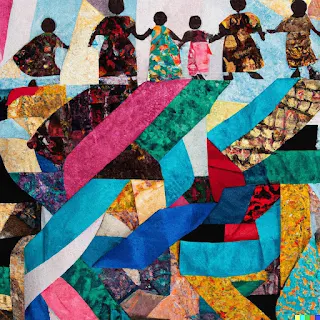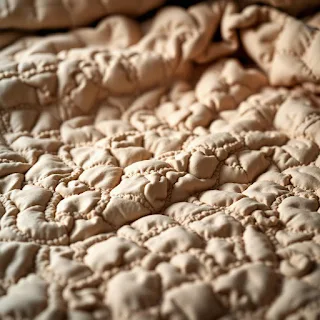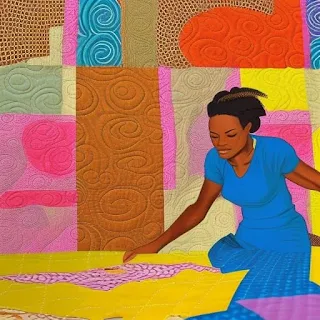Quilting in Liberia holds profound historical, cultural, and symbolic significance, representing freedom, resilience, and identity for former slaves and their descendants. Quilts serve not only as practical objects but also as intricate works of art, storytelling tools, and symbols of heritage. Through quilting, Liberians preserve their African traditions, share their histories, and celebrate their connections to community and liberty. Use this article as a source of inspiration for your own creative quilting projects whether it's recreating traditional Liberian patterns or developing new designs.
Threads of Freedom: The Cultural, Historical, and Symbolic Power of Quilting in Liberia
In Liberia, quilting holds a special meaning. It represents freedom and liberty, and the beautiful and meaningful quilts reflect the history and identity of the people who make them. Liberians preserve and celebrate African heritage and culture through quilting, making it a powerful symbol of their identity and strength. The significance of quilting in the lives of former Liberian slaves resonates as a testament to the enduring power of art, resilience, and cultural heritage in the face of historical injustice.
Three Fascinating Stories of Quiltmaking for VIPs in Liberia.
In Liberia, people, especially women, first expressed themselves through quilting. Former slaves in Liberia combined quilt patterns and hand sewing as a path to freedom. Oral history has been around longer than written history. Quilts served as a story, clothing, bedding, window and door coverings, and freedom for African slaves.
Fabric is lifeless, but in the hands of former slaves from Liberia, quilting became a symbol of freedom and liberty. Quilts in Liberia are often used as gifts for special occasions, such as weddings, births, graduations, and diplomatic visits. These tapestries are not your usual quilts, which are handcrafted affectionately by your grandmother and kept on your bed or in your cedar closet. Instead, they are detailed and complex pieces of art.
Martha Ann Erskine Ricks, a former Liberian slave, met Queen Victoria and presented her with a beautiful quilt she had spent half of a century quilting.
The American Colonization Society (ACS) was founded in 1816 by Robert Finley and other prominent white Americans to promote the migration of free blacks and freed slaves to Africa. The society believed that free blacks could not integrate into U.S. society and that their presence would threaten the institution of slavery. The organization received funding from the federal government and some state legislatures, as well as from churches and private donors.
The society's first ship, the Elizabeth, departed from New York on February 6, 1820, carrying 88 black emigrants and three white agents to West Africa. After a failed attempt to settle on Sherbro Island, the society acquired a piece of land on Cape Mesurado, where they founded the colony of Liberia in 1822.
Americo-Liberian quilter and farmer Martha Ann Erskine Ricks was born a slave in Tennessee in 1817, but her father bought their freedom and moved them to Liberia in 1830 through the ACS. The cost of sailing from the U.S. to Liberia in 1820 was about $50 per person, equivalent to about $1,200 in 2023.
Over 50 years, she dedicated her efforts to creating a stunning quilt that showcased a blossoming Liberian coffee tree made from satin ribbons and random pieces of fabric. She carefully crafted the piece using cotton silk from a nearby tree and cotton, creating a beautiful piece of art from natural materials. from raw materials.
Mrs. Ricks, in 1892, at 76 years old, began her unofficial journey to see Queen Victoria. She traveled in the company of the wife of the ex-president of Liberia, Jane Waring Roberts. When Mrs. Ricks arrived in England, Presbyterian minister Edward Wilmot Blyden wrote to Sir Henry Ponsonby, Private Secretary to Queen Victoria, telling him of the arrival in England of Mrs. Ricks and her wish to meet the Queen. Sir Henry Ponsonby replied, proposing an unofficial visit since the necessity of applying for an official visit through the Foreign Office would take time and a telegram.
Queen Victoria hosted Mrs. Ricks at the palace during a luncheon with her children, grandchildren, and dignitaries such as Lord and Lordess Mayor, Princess Louise, Princess Beatrice, Prince and Princess of Wales, and Princess Victoria and Maud.
The Queen reportedly told Mrs. Ricks, "I am honored by all the trouble you took to meet me and present me with this beautiful quilt." The Queen was deeply moved by the quilt and the fascinating story behind it, which she noted in her diary. Queen Victoria, during her reign, had a passion for fiber arts, finding joy and relaxation in the art of knitting and crocheting.
During her visit to TD Jakes's popular mega-church in Dallas, Texas, former President of Liberia Ellen Johnson Sirleaf gifted him with a handmade quilt.
Her Excentcly Ellen Johnson Sirleaf was Liberia's first elected female president, two years after the nation's bloody civil war ended. She served from 2006–2018 as the 24th president of Liberia and the first woman to be elected head of state of an African country. She was also one of the recipients of the 2011 Nobel Peace Prize for her efforts to further women's rights. There is a tradition in Liberia of giving quilts to dignitaries.
One such quilt was given to the popular Nondenominational Christian preacher and entrepreneur Bishop TD Jakes during a dinner he hosted at his home in Dallas, Texas. TD Jakes stated he loved the quilt and expressed gratitude and appreciation for the thoughtful and cherished gift that was presented to him. Her Excentcly Sirleaf gave TD Jakes a short history lesson on how quilting symbolizes freedom and liberty in Liberia.
Quiltmaking in Liberia is a tradition that dates back to the 19th century, when Black Americans, some of whom were formerly enslaved, settled in West Africa and established a colony that later became Liberia. They brought with them their skills and culture of quiltmaking, which they adapted to the local environment and materials.
President John F. Kennedy was gifted with a beautiful Liberian Quilt.
Learning that quilts are commonly given as gifts to celebrate significant milestones and even diplomatic visits in Liberia is fascinating. It's a beautiful tradition that speaks to the value of handmade items and the importance of commemorating life's special moments.
During a meeting on June 26, 1961, President John F. Kennedy met with Liberia's Vice President, William R. Tolbert. Also present were Liberian Ambassador George Padmore and Deputy Director of the Office of West African Affairs Wendell B. Coote. In a display of friendship and goodwill, a quilt featuring the flags of both nations and a map of Liberia was gifted.
William R. Tolbert Jr. was the 20th President of Liberia from 1971 to 1980. His presidency focused on promoting national unity and economic development. He even used quiltmaking associations as a political peace agreement. However, Tolbert and some high-ranking officials were arrested and executed by firing squad on April 22, 1980, despite his efforts.
Quilting held deep meaning for former Liberian slaves.
Quilting may seem like a simple act of sewing together pieces of fabric, but for former slaves from Liberia, it was much more than that. Through their skillful hands, they turned quilting into a powerful symbol of freedom and liberty. It's incredible how something lifeless like fabric can come alive with such meaning and significance in the hands of these talented individuals.
Like life, quilting is a beautiful tapestry woven with patience, creativity, and resilience. Just as a quilter carefully selects and stitches together various fabric pieces, we navigate through life's challenges, stitching together our experiences, relationships, and lessons. Both quilting and life require attention to detail, as the tiniest stitches and fabric choices can significantly impact.
Just as a quilt is composed of different patterns, colors, and textures, life embraces diversity and teaches us the value of embracing our unique qualities and those of others. Quilting also teaches us the power of perseverance, as each stitch represents dedication and determination to see a project through to completion.
Similarly, life presents us with obstacles and setbacks, but we can overcome them with determination and create something beautiful. Ultimately, both quilting and life remind us that every piece, no matter how small or seemingly insignificant, contributes to the overall beauty and significance of the final creation.
Quilting held a profound and poignant meaning for former Liberian slaves, transcending its practical and artistic aspects. As they stitched together fabric remnants, quilting became a powerful symbol of resilience, identity, and connection to their African heritage. Quilts served as historical records for these individuals, narrating their journey from bondage to freedom.
They communicated their stories, hopes, and dreams through patterns and motifs. Quilts became a means of preserving cultural traditions and passing down ancestral knowledge to future generations. Associations of Liberian Women who produced quilts for national and international use. Quilting circles in Liberia fostered a sense of community and solidarity, providing a space for healing, support, and shared experiences.
In the face of adversity, quilting became a source of empowerment, allowing former slaves to reclaim their agency and celebrate their humanity. The significance of quilting in the lives of former Liberian slaves resonates as a testament to the enduring power of art, resilience, and cultural heritage in the face of historical injustice.
How to Make a Cotton Quilt for Your Beloved Pet
Looking for a cozy and comfortable quilt for your furry friend? Check out our cotton quilts, perfect for cats and dogs alike. Your pet will love snuggling up in this soft and warm blanket.
This tutorial will show you how to create a cozy, comfortable quilt for your furry friend. A quilt is a great way to keep your pet warm and cozy. You can make your own quilt with some fabric, batting, and a sewing machine. If you want to make a cotton quilt for a fur baby, follow some steps.
1. Choose a pattern for your quilt. You can find some free patterns online or use your own design. Make sure the pattern is suitable for a baby quilt, which is usually about 36 by 54 inches in size.
2. Purchase your fabric. Look for high-quality quilting cotton for your quilt top and back. You will also need some batting, which is the layer between the top and back that gives the quilt warmth and thickness. You can use extra loft 100% polyester batting for a soft and fluffy quilt.
3. Cut your fabric according to your pattern. You will need to cut squares, rectangles, or other shapes depending on your design. You can use a rotary cutter and a cutting mat for accuracy and speed.
4. Piece your quilt top. Sew the fabric pieces together using a 1/4 inch seam allowance. Press the seams open or to one side with an iron. You can use pins or clips to hold the pieces together as you sew.
5. Assemble your quilt sandwich. Lay the quilt back on a large flat surface, right side down. Smooth out any wrinkles and tape the edges to the surface. Place the batting on top of the quilt back and smooth it out as well. Then place the quilt top on top of the batting, right side up. Make sure all the layers are aligned and smooth.
6. Quilt the layers together. You can use a sewing machine or hand stitch to quilt your quilt. Quilting is the process of sewing through all the layers of the quilt sandwich to hold them together and create a decorative pattern. You can follow the lines of your pieced design or create your own quilting motif.
7. Trim and bind your quilt. After quilting, trim the excess fabric and batting around the edges of your quilt with scissors or a rotary cutter. Then make and attach the binding, which is a strip of fabric that covers the raw edges of your quilt and gives it a finished look.
Congratulations! Using natural cotton, you have made a Cotton Quilt for Your Beloved Pet inspired by Liberia.












